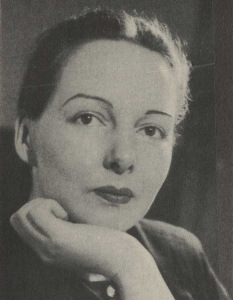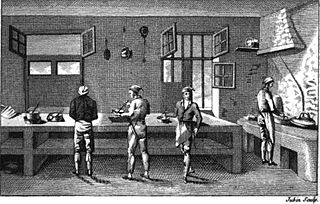
A cookbook or cookery book is a kitchen reference containing recipes.

Jean Anthelme Brillat-Savarin (French pronunciation:[ʒɑ̃ɑ̃tɛlmbʁijasavaʁɛ̃], was a French lawyer and politician, who, as the author of Physiologie du goût, became celebrated for his culinary reminiscences and reflections on the craft and science of cookery and the art of eating.

Mary Frances Kennedy Fisher Parrish Friede, writing as M.F.K. Fisher, was an American food writer. She was a founder of the Napa Valley Wine Library. Over her lifetime she wrote 27 books, including a translation of Brillat-Savarin's The Physiology of Taste. Fisher believed that eating well was just one of the "arts of life" and explored this in her writing. W. H. Auden once remarked, "I do not know of anyone in the United States who writes better prose." In 1991 the New York Times editorial board went so far as to say, "Calling M.F.K. Fisher, who has just been elected to the American Academy and National Institute of Arts and Letters, a food writer is a lot like calling Mozart a tunesmith."

Gastronomy is the study of the relationship between food and culture, the art of preparing and serving rich or delicate and appetizing food, the cooking styles of particular regions, and the science of good eating. One who is well versed in gastronomy is called a gastronome, while a gastronomist is one who unites theory and practice in the study of gastronomy. Practical gastronomy is associated with the practice and study of the preparation, production, and service of the various foods and beverages, from countries around the world. Theoretical gastronomy supports practical gastronomy. It is related with a system and process approach, focused on recipes, techniques and cookery books. Food gastronomy is connected with food and beverages and their genesis. Technical gastronomy underpins practical gastronomy, introducing a rigorous approach to evaluation of gastronomic topics.

Craig Claiborne was an American restaurant critic, food journalist and book author. A long-time food editor and restaurant critic for The New York Times, he was also the author of numerous cookbooks and an autobiography. Over the course of his career, he made many contributions to gastronomy and food writing in the United States.

Michael Kevin Pollan is an American author and journalist, who is currently Professor of the Practice of Non-Fiction and the first Lewis K. Chan Arts Lecturer at Harvard University. Concurrently, he is the Knight Professor of Science and Environmental Journalism and the director of the Knight Program in Science and Environmental Journalism at the UC Berkeley Graduate School of Journalism where in 2020 he cofounded the UC Berkeley Center for the Science of Psychedelics, in which he leads the public-education program. Pollan is best known for his books that explore the socio-cultural impacts of food, such as The Botany of Desire and The Omnivore's Dilemma.
Gourmet magazine was a monthly publication of Condé Nast and the first U.S. magazine devoted to food and wine. The New York Times noted that "Gourmet was to food what Vogue is to fashion." Founded by Earle R. MacAusland (1890–1980), Gourmet, first published in January 1941, also covered "good living" on a wider scale, and grew to incorporate culture, travel, and politics into its food coverage. James Oseland, an author and editor in chief of rival food magazine Saveur, called Gourmet "an American cultural icon."

Ruth Reichl, is an American chef, food writer and editor. In addition to two decades as a food critic, mainly spent at the Los Angeles Times and The New York Times, Reichl has also written cookbooks, memoirs and a novel, and has been co-producer of PBS's Gourmet's Diary of a Foodie, culinary editor for the Modern Library, host of PBS's Gourmet's Adventures With Ruth, and editor-in-chief of Gourmet magazine. She has won six James Beard Foundation Awards.

Kim Marie Severson is a reporter for The New York Times. She won a Pulitzer Prize for public service in 2018 as part of The New York Times coverage of sexual harassment and abuse and is a four-time James Beard award–winner for food writing. Severson has published multiple cookbooks and a cooking themed memoir.

Heartburn is an autobiographical novel based on Nora Ephron's marriage to and divorce from Carl Bernstein, her second husband. Originally published in 1983, the novel draws inspiration from events arising from Bernstein's affair with Margaret Jay, the daughter of former British prime minister James Callaghan. Ephron also wrote the screenplay for the 1986 film adaptation.

Marcel Rouff was a Swiss novelist, playwright, poet, journalist, historian, and gastronomic writer. With Curnonsky he wrote the multi-volume work La France gastronomique, guide des merveilles culinaires et des bonnes auberges françaises. He may be best known today for his novel about the fictional gourmet Dodin-Bouffant, La vie et la passion de Dodin-Bouffant, Gourmet, which was first published in 1924 and dedicated to his friend Curnonsky and the great nineteenth-century French gastronome Jean-Anthelme Brillat-Savarin. Rouff's novel was adapted for French television in 1973 by Jean Ferniot and in a 2023 feature-length movie by Trần Anh Hùng, The Taste of Things ·.

Michael Carl Ruhlman is an American author, home cook and entrepreneur.

A dish in gastronomy is a specific food preparation, a "distinct article or variety of food", ready to eat or to be served.

Antoine B. Beauvilliers was a French restaurateur who opened the first grand restaurant in Paris and wrote the cookbook L'Art du Cuisinier. Jean Anthelme Brillat-Savarin considers him the most important of the early restaurateurs, as "he was the first to have an elegant dining room, handsome well-trained waiters, a fine cellar and a superior kitchen." Beauvilliers is described as a "portly figure, his triple chin, his broad, joyous face, and the light that sparkles in his large grey eye." He dressed fashionably and carried a sword. His success was enhanced by his ability to "cater to and flatter rich patrons", attending to them personally and helping them with items on the menu; he had a prodigious memory and could recall a patron he had not seen in 20 years.
Judy Rodgers was an American chef, restaurateur, and cookery book writer. She became famous at Zuni Café, in San Francisco, California, of which she became chef in 1987. Rodgers' food was influenced both by Chez Panisse, where she had worked, and by the food of France, where she had spent time as an exchange student living with the family of Jean Troisgros. The Zuni Café Cookbook, published in 2002, spread the influence of her painstaking, attentive approach to food further outside the United States.
Priya Krishna is an Indian-American food journalist and YouTube personality. She is a food reporter for The New York Times and has previously contributed to The New Yorker, Eater, and TASTE. She is also the author of multiple cookbooks, including Indian-ish, a cookbook she wrote with her mother.
The James Beard Foundation Awards are annual awards presented by the James Beard Foundation to recognize culinary professionals in the United States. The awards recognize chefs, restaurateurs, authors and journalists each year, and are generally scheduled around James Beard's May birthday.
The James Beard Foundation Awards are annual awards presented by the James Beard Foundation to recognize culinary professionals in the United States. The awards recognize chefs, restaurateurs, authors and journalists each year, and are generally scheduled around James Beard's May birthday.

Jane Nickerson was an American food writer, newspaper editor, cookbook editor, and restaurant critic. She created the position of food editor at The New York Times and was instrumental in the professional development of James Beard and Craig Claiborne. She was influential in the modernization of food journalism.
Food journalism is a field of journalism that focuses on news and current events related to food, its production and culture of producing and consuming that food. Typically food journalism includes a scope broader than the work of food critics who analyze restaurants and food products, and is similar to, and sometimes treated as a sub-genre of food writing, which documents the experience and history of food.













